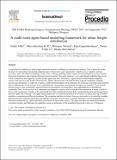A multi-scale agent-based modelling framework for urban freight distribution
Author(s)
Alho, André; Bhavathrathan, B.K.; Gopalakrishnan, Raja; Le, Diem-Trinh; Stinson, Monique; Ben-Akiva, Moshe E; ... Show more Show less
Download1-s2.0-S2352146517310359-main.pdf (1.166Mb)
PUBLISHER_CC
Publisher with Creative Commons License
Creative Commons Attribution
Terms of use
Metadata
Show full item recordAbstract
Comprehensive modelling of urban freight operations remains a challenge in transportation research. This is partly due to the diversity of commodities transported, shipment units, vehicle types used, stakeholders’ objectives (e.g. suppliers, carriers, receivers), and to the limited availability of data. Thus, existing modelling efforts require several assumptions yet have limited behavioral foundations and minimal interaction between agents. This paper proposes a new agent-based modelling framework, which considers the heterogeneity of urban freight agents and their interactions. Agents include establishments (suppliers, carriers, and receivers) and freight vehicle drivers. Agents’ decisions are structured in three temporal resolutions: strategic, tactical, and operational. A single set of agents is represented throughout all modelling levels ensuring a consistent and sequential flow of information. At the strategic level, establishments’ characteristics and strategic decisions are modelled. These include location choices, fleet constitution, annual production/consumption of commodities, and establishment-to-establishment commodity flows. At the tactical level, shipments are assigned to carriers, who in turn plan their operations in terms of vehicle-driver-route assignments. Finally, at the operational level, the interactions between daily operational demands and transportation network supply are simulated. The supply representation has two different resolution levels (micro or meso) allowing for either detailed or computational efficient simulation. The simulation platform is distinct from previous works, as it explicitly considers planning horizons, replicates agent decision makings/interactions and involves a structure that allows for the propagation of influences bottom-up (e.g., prior simulation travel times on future route choice). The paper describes the simulation platform, constituent models, and illustrates its capabilities using an application of the modelling framework to the city of Singapore. Keywords:
freight transport; city logistics; commodity flow; freight tours; simulation; ABM
Date issued
2018-01Department
Singapore-MIT Alliance in Research and Technology (SMART); Massachusetts Institute of Technology. Intelligent Transportation Systems LaboratoryJournal
Transportation Research Procedia
Publisher
Elsevier BV
Citation
Alho, André et al. “A Multi-Scale Agent-Based Modelling Framework for Urban Freight Distribution.” Transportation Research Procedia 27 (2017): 188–196 © 2017 The Author(s)
Version: Final published version
ISSN
2352-1465